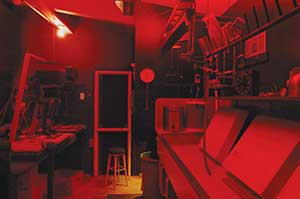

There are no people in any of these pictures,” said Annie Leibovitz as she walked us through a preview of “Pilgrimage” at the San Jose Museum of Art. “It’s a personal show, a small jewel of a show. There’s no reason why anything has to be big.”
“Pilgrimage” first incubated at the former houses of both Emily Dickinson and her brother, who lived next door. In a somewhat dark milieu, where the descendants really didn’t know what to do with the remaining artifacts, Leibovitz began shooting the mementoes with a Canon G10, and ideas began to emerge. A photo of Dickinson’s only remaining nightgown is now on the wall at the San Jose Museum of Art, as are shots of her pressed plant specimens.
From there, Leibovitz traveled throughout the United States and England, capturing artifacts from the immediate environments of certain artists, writers and other eccentric individuals.
She wasn’t on assignment. There are no celebrity shots, no portraits, nothing of Drew-what’s-her-name, just personal items and spaces that touched Leibovitz in some way: Pete Seeger’s workshop, where, apparently, a few tools haven’t been moved in 10 years. Marian Anderson’s dress, with one particular piece of red felt sewn into it. Georgia O’Keeffe’s handmade pastels left over from when she was still actively painting, as well as a shot of her adobe patio. Ansel Adams’ famous darkroom. The television Elvis Presley blew a hole in.
“David Letterman told me Elvis always shot the television whenever Robert Goulet came on,” Leibovitz said.


As Leibovitz further explained, “Pilgrimage” is about visual preservation and note taking. She learned about the history of each environment as the pilgrimage unfolded. At Graceland, for example, the bullet-ridden TV is not even on display for the public. It’s actually kept in a storage room.
When she visited Virginia Woolf’s writing studio and farmhouse, still open for public tours, Leibovitz found what already resembled a preserved still life.
Woolf’s desk was covered with ink stains, the wind came in through the window, the flowers looked gorgeous and the chilly British weather dominated the overall scene, which now seemed perfectly staged for Leibovitz to photograph. She even walked down to the River Ouse where Woolf killed herself; a tranquil photo of the water appears in the show.
As she traveled for a few years documenting these environments, Leibovitz said the domino effect came into play, whether it was the former homes of Emerson, Thoreau or Louisa May Alcott. One place led to, and necessitated, the next.
Anderson’s old dress, for instance, sits right next to relics from Gettysburg, which, in turn, sit right next to a drop-dead gorgeous shot of Seeger’s workshop. Seeger has lived on a hill above the Hudson River in Cold Spring, N.Y., since 1949. His workshop shows it.
“He’s the Lincoln of our time,” said Leibovitz, who joked, laughed, philosophized, reminisced and even teared up at certain times while taking us through the show. Leibovitz is clearly a living legend, no longer bound to expectations surrounding her career. She repeated several times that “Pilgrimage” is a personal expression, with no need for grandiosity.
“Pilgrimage” is also first major endeavor in the digital realm, as opposed to film, and Leibovitz claimed to still be a student at digital. Ultimately, she said, it all came down to vision.
“Our vision, and what we’re seeing, is changing,” she mused. “What everyone disliked about digital to begin with—everything being so sharp—is now something we really thrive on, and we like. We want to see things sharp. Before we didn’t want to see sharp. And now it’s like ‘How much information can we get in this?’ Pick up a copy of National Geographic. They go deeper into the ocean and higher into the sky. It’s a thrilling moment right now. It’s very exciting.”
Runs through Sept 8


